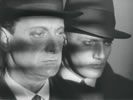Eye For Film >> Movies >> Blackmail (1929) Film Review
Blackmail
Reviewed by: Leanne McGrath

The Master of Suspense's first talking picture is the template for many of his later masterpieces.
Blackmail has all the hallmarks of classic Hitchcock - tension, intrigue, murder, romance and, of course, the kind of exquisite direction most directors can only dream of.

The film follows Alice White (Anny Ondra) who sneaks away from her fiance, Detective Frank Webber (John Longden) to meet another man - suave artist Mr Crewe (Cyril Ritchard).
He persuades her to come in to his apartment to see his art studio but once there attempts to rape her. She knifes him to death and flees in a daze.
Frank is called upon to investigate the murder and finds one of Alice's gloves at the scene. He hides the evidence to save his love - but he is not the only one who knows of her crime. Dubious ex-con Tracy (Donald Calthrop) saw and heard everything... and wants them to make it worth his while to stay quiet.
Blackmail was originally made with just a recorded score as a silent film and the style reflects this. The movie is extremely melodramatic with excessive mise-en-scene in regards to the actors' facial expressions and make-up.
The lack of sound meant they had to exaggerate image to give meaning. With incredible foresight, Hitchcock predicted the studio may decide Blackmail was to become a talkie and shot it in such a way that it was easy to reshoot some scenes with sound. But there were problems to overcome. His leading lady, Anny Ondra, had her voice recorded by another actress because Alice is a cockney and Anny had a strong Polish accent. But in the days before dubbing, this meant Brit actress Joan Barry had to speak into a microphone next to the camera while Hitch was shooting - and the lip-synching is pretty ropey at times.
Hitchcock was clearly interested in the shift towards sound pictures - which had its critics and supporters - and Blackmail explores the use of the new technology and how it can add meaning to movies.
After she has committed her crime, Alice freezes everytime she hears bird song or whistling because the artist whistled. At the breakfast table, a family friend is discussing the murder and repeats the word knife. Hitch cleverly drowns out all other sound so this is all Alice, and the viewer hear. It pierces the silence as it literally stabbed the artist.
But on the other hand, sound is never more important than image. Hitch is famous for letting viewers use their imagination - what we see will always be more terrifying than anything he can show us.
Blackmail's superb murder scene is no different. You only see a scuffle behind a curtain and her hand grabbing the knife. Another triumph of image over sound is when the artist's landlady Mrs Humphries (Hannah Jones) tries to describe a man - Tracy- who was hanging around outside the building. She can't find the words - but recognises a picture of him.
Blackmail may not have the polish of later classics such as Psycho, Rear Window or Vertigo due to the early, poor, sound technology but it is an interesting look at Hitch's beginnings and shows that even in the early days he had an incredible talent for suspense, storytelling and spine-tingling drama.
Reviewed on: 26 Feb 2007

















